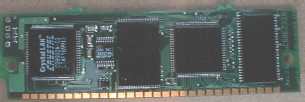
|
Quality Information in one Place . . .
|
IP & Ethernet Interfaces

|
Quality Information in one Place . . .
|
Seiko Instruments Inc have come up with what should be a very popular chip. Having already picked up the Electronic Products 1999 Product of the Year Award, the S-7600A is a 48 pin package which takes care of the TCP/IP stack in hardware. This allows quite dumb processors the ability to talk on the internet. The S-7600A incorporates a UART which is connected to the internet using PPP (Point to Point Protocol) either via a dedicated link or via a dial up modem. A microcontroller can then send the S-7600 streams of information which is automatically encapsulated in a TCP/UDP datagram and sent using IP.
S-7600A
This has a wide range of uses, such as allowing your data logger to dial up the internet and FTP it's data to your server or email you alarms and summaries. Coupled with a GSM or mobile phone, you can get alarms via email from any number of devices - pumping stations - weather instruments - toasters! You name it. The internet, being a cost effective transmission medium allows cheaps calls to a local ISP which can then be relayed to the other side of the world if need be via the internet.
On the less practical hobbyist side, but far more enjoyable, you could endeavour to make the world's smallest Web Server. Certain debate lies if you could use a 8 Pin PIC12C508, but it has been done with a PIC16F84! See Small Web Server based on the PIC16F84
There has been suggestions that Seiko Instruments are looking at releasing a TCP/IP stack with an Ethernet Interface. Certainly this would be of more interest to many, thus we can only wait for such a device to become available. . . . . (Please send samples my way - Sekio!)
The uCSimm has been a very popular module ever since one little advertisement in Circuit Cellar. The uCSimm is an embedded Ethernet module ideal for Internet connectivity. Based on a Motorola 68K running Linux there is no limits to what you can achieve with this unit. If your imagination isn't with you today, check out the uCSimm and uCLinux Forums on http://www.rt-control.com

|
uC68EZ328
|
For those who can't help making their own (Maybe with extra I/O or no conformal coating on the gold contacts . .) this device uses a 68EZ328 Dragon Ball Processor. Motorola has a 68EN302 processor, based on their 68K Architecture complete with Embedded Ethernet Interface. While this seems the better option, reality is that you can't obtain these easily and they use a normal medium speed crystal. The dragonball on the other hand will run from DC to 16.58 MHz with 2.7 MIPS performance. What is quite useful is the 68EZ328's ability to generate it's 16.58MHz internal clock with a tiny 32.768 kHz crystal using it's internal PLL clock Multiplier. Ideal for those small locations. The uCSimm has two small crystals tucked on the back of the module.
The 68EN328 has a built in DRAM controller which requires no Glue Logic. This, coupled with a CS8900A LAN Controller makes the module so simple, anyone could wack one together customised to their specs. Even the software is a breeze with the unit running on uClinux, an open source embedded Linux. With all this functionality, I have to ask - who needs an embedded I386?
The TINI standing for Tiny InterNet Interface is a product of Dallas Semiconductor. It's very simular to the uCSimm and you could easily mistake it for a uCSimm from a distance. Both the uCSimm and TINI come with daughter boards for testing. The TINI module runs on JAVA using what Dallas calls a JAVA Processor. I believe it's a 8051 variant. . .
TINI |

|
Dallas have released circuit diagrams of the TINI Module. The software however is copyright and needs to be licenced before you can distribute it.